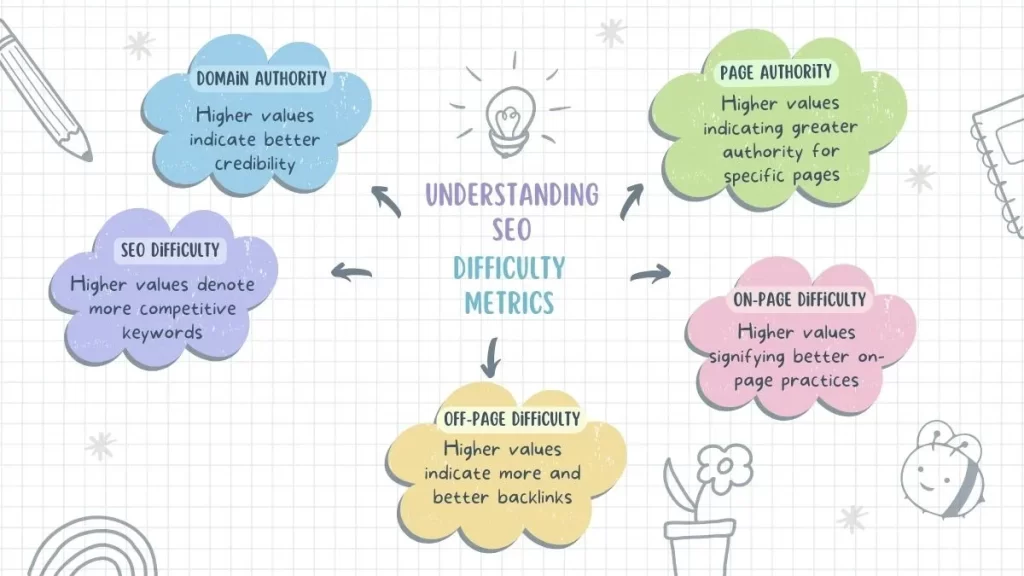What is Keywords Everywhere?
Keywords Everywhere is a popular keyword research tool that makes finding and analyzing keywords incredibly simple. It is available as a free Chrome extension and Firefox add-on that overlays helpful keyword data directly onto Google search results pages (SERPs).
Some of the key information Keywords Everywhere provides includes:
– Related keywords and long-tail keyword suggestions
– Monthly search volume estimates
– Cost-per-click (CPC) data
– Keyword competition metrics
– Historical search trends dating back to 2004
Unlike other keyword tools, there is no need to switch between multiple interfaces. Everything is conveniently accessible from within the extension on Google itself.
Key Benefits of Using Keywords Everywhere for SEO
There are several reasons why Keywords Everywhere has become a go-to tool for marketers and SEO professionals:
1. Saves time – Research can be done faster without opening multiple tabs and tools.
2. Provides accurate data – Leverages multiple data sources like Google and YouTube.
3. Identifies new opportunities – Discovers valuable long-tail and related keywords.
4. monitors trends – Historical charts show popularity over time.
5. Affordable pricing – Pay only for the searches you need.
6. Easy to use – Simple interface and no learning curve.
Optimizing your content with Keywords Everywhere is a proven way to increase your organic traffic and SERP rankings. Continue reading this comprehensive guide to learn how.
Also Read: A Comprehensive Guide to PaaS, SaaS, IaaS, and CaaS Cloud Computing Models
Getting Set Up with Keywords Everywhere
Installing the Chrome Extension
The first step is to install the Keywords Everywhere extension for Google Chrome or add-on for Mozilla Firefox.
To do this:
1. Visit the Keywords Everywhere website
2. Click “Add to Chrome” or “Add to Firefox”
3. In the pop-up, click “Add Extension” to finish installing

That’s all there is to it! The extension will now be enabled and ready to start using on Google Searches.
Setting Up a Paid Account
The free version of Keywords Everywhere offers basic functionality, including related keywords and long-tail suggestions from the SERPs.
For unlimited use of more advanced features like search volume data, historical trends, and CPCs, a paid plan is required.
Here is how to upgrade to premium access:
Getting Your API Key
1. In the extension popup, click “Get API Key“
2. Enter your email address
3. Check the boxes to agree to the Terms of Service and Privacy Policy
4. Click the button to have your unique API key emailed

Purchasing Credits
1. Copy the API key from the email and paste into the extension’s “API Settings”
2. Click validate to connect your account
3. Under the settings menu, choose your desired Credit Package
4. Make the purchase with card details
100,000 credits typically lasts solo users about 6 months for ~$10.
Activating Paid Features
1. Once credits are loaded, toggle the switch to enable “Paid Features”
2. The metrics and data will now be unlocked across the extension
You are all set to harness the full power of Keywords Everywhere!
Also Read: The Complete Guide to Funding Your SaaS Startup: Strategies and Best Practices
Using Keywords Everywhere for SEO
Now for the fun part – time to see the tool in action for boosting SEO!
Extracting Keyword Data from Google SERPs
Understanding SEO Difficulty Metrics
One of the first things you will notice after installing the extension are the handy metrics that appear beside Google search results. These provide an overview of SEO difficulty related to ranking that particular keyword or page.
Here is a breakdown of what each value represents:

Domain Authority – Estimate of a site’s credibility and ability to rank in SERPs based on backlinks and other trust factors. Higher = better.
Page Authority – Similar to Domain Authority but evaluates the individual page instead of full domain. Higher = more authority.
SEO Difficulty – General metric for estimated difficulty of a page ranking for that keyword. Factors include on-page SEO quality, backlinks strength, page speed and more. Reported on a scale of 0 – 100. Higher = more competitive keyword.
On-Page Difficulty – Specifically rates how optimized a page’s on-site elements are that allow it to rank well such as title tags, content, headings structure and internal links. Higher = better on-page practices.
Off-Page Difficulty – Evaluates how many quality external links are pointing to a page, which is a strong Google ranking factor. Higher = more/better backlinks.
Viewing Search Trends
The extension also includes handy search popularity trend charts for keywords spotted on SERPs and YouTube. These display monthly interest historically over time dating back nearly 20 years.
Observing spikes and dips can indicate:
Seasonal keywords – Peak during certain holidays
Steady demand – Consistent search volume
Fading interest – Declining searches
This data allows you to gauge if keywords are rising or falling in popularity to focus on what users are searching.
Finding Related Keywords
At the top of the extension will be various other keyword ideas you can target and optimize for. These include:
Related keywords – Similar searches to what you entered also trending
Long-tail versions – Very specific keyword variations with 3+ words
“People also search for” – Other queries users searched around the same topic
The long-tail keywords with lower competition provide opportunities to rank content and drive targeted organic traffic. The others reveal broader terms to go after.
Identifying “People Also Search For” Terms
Pay close attention to “People Also Search For” keyword suggestions in particular. These represent the exact follow-up searches people enter related to your initial keyword.
Optimizing for these secondary queries can align your content perfectly with the searcher’s intent and flow between terms. This helps pages better answer multiple staged questions leading to conversions.
Discovering Long-Tail Keywords
As highlighted above, targeting long-tail versions containing 3 or more words with less competition but still decent search volume can be rewarding.
These ultra specific queries indicate the user clearly knows what they want, providing a prime chance to get your page to rank and for them to convert. Their more narrowed focus directly matches intent with your product/service solution.
Also Read: Best Social Media Channels for SEO of SaaS Companies
Selecting Target Keywords
The information Keywords Everywhere surfaces can feel overwhelming, so next we discuss how to select prime terms and phrases to focus your optimization efforts.
Analyzing Keyword Density
Keyword density refers to the percentage/frequency at which a word or phrase appears on a page in relation to total word count. Generally 1-3% density is recommended to avoid over-optimization penalties.
Luckily the extension makes understanding the distribution easy via its Analyze Page Content report.
Simply search for any URL or competitor page. The tool will detect keywords present and provide helpful data:
Found in – Title tag, Heading (H1, H2) or body
Density % – Frequency/distribution
Occurrences – Total repetitions
Monthly Volume – Global searches
CPC – Cost-per-click paid ads
Competition – 0 (Low) to 1 (High)
Sorting by volume and competition is a quick way to add likely winners to your targeting list that also appear appropriately integrated for Google.
Performing Competitor Analysis
Another excellent use is comparing your current rankings to competitors by leveraging Keywords Everywhere’s domain vs. URL analysis to uncover:
Organic Ranking Keywords (URL) – Which keywords THAT PAGE ranks for
Organic Ranking Keywords (Domain) – Which keywords the full site ranks for
You can also discover the top pages driving the most organic traffic for them.
This makes it possible to:
– Learn from their optimization successes
– Identify high potential targets you may be missing
– Create better content improving upon theirs
The learnings here provide a content roadmap and list of proven winners from top performers in your space.
Also Read:The Complete Guide to Guest Posting for SaaS Business Growth
Comparing Your Site’s Performance
Taking competitor research one step further, you can run a detailed comparative analysis to reveal keyword gaps between domains.
Viewing Organic Ranking Keywords
As covered in the previous section, viewing the organic keywords ranked for both by URL and full domain supplies intelligence to apply to your own site.
Try comparing your homepage, category pages, and recent blogs against your top competitors to find inspiration.
Identifying Top Pages
Look at the specific pages driving the highest visibility for competitors using Keywords Everywhere’s Top Pages tool. This displays the URLs responsible for the most search traffic along with their ranked keyword totals.
Evaluate why these location pages work so well – is it the content? The optimization? The authority flow? Knowing the pages earning the best results provides a model after which to pattern your own site’s top level pages.
Discovering Keyword Gaps
One of the most actionable reports is the Competitor Gap Analysis. This reveals the terms a domain ranks for that YOUR domain does not.
Adding these proven winners to your content optimization checklist is a smart way to make progress closing the visibility gap by targeting what already drives visitors to rivals.
The key is translating learnings into growth with urgency before they potentially build upon advantages even further with machine learning & analytics.
Also Read: SaaS Marketing Guide: Differences, Effective Strategies, and Best Practices
Optimizing YouTube SEO
Increasingly, video has become a must-have component for lead generation and SEO success. Let’s examine how Keywords Everywhere can uplevel your YouTube channel strategy.
Evaluating Search Insights
The #1 advantage Keywords Everywhere offers is context without having to leave the search engine. This holds true for YouTube’s platform as well.
Beside video results, the extension supplies metrics like:
– Ranking Difficulty
– Average & Max Views
– Videos per Day
– Optimization Score
Consider difficulty scores and view counts when weighing keyword targets. Higher visibility despite difficulty indicates strong potential.
Reviewing Trend Data
As with Google keyword data, historical interest charts help better plan YouTube video focus.
You can instantly visualize whether a topic has consistent, rising or declining searches over time.
Pair this context with the search insights to make informed keyword selections for long term channel success.
Finding Relevant Tags
Pay close attention to the “Most Used Tags” that Keywords Everywhere detects associated with a search term or channel niche. These tags are essentially YouTube’s version of keywords, helping videos surface for given queries.
Ensure your top keyword targets are properly leveraged and integrated within video titles, descriptions and these Most Used Tags.
Also Read: The Ultimate Guide to SaaS Marketing Automation Tools: 21 Essentials
Exporting Keywords for Further Analysis
At this point you likely have accumulated a lengthy list of keyword possibilities across metrics like search volume, competition level, historical trends and more.
To enable further analysis and prioritization in other tools, use Keywords Everywhere’s handy export options:
– PDF report
– Excel (.csv) spreadsheet
– Search Volume CSV
Integrations like Google Sheets allow creating charts to visualize factors like CPC vs. volume for additional insights.
Leveraging Your Keyword Research
The purpose of all this extensive keyword research is to create higher quality content that aligns with user intent and earns increased organic visibility as a result.
Expanding Ideas with Autocomplete
A clever way to discover even more search suggestions is leveraging Google’s autocomplete function.
As you begin typing a phrase, Google will predictively show multiple continuations in a dropdown menu. These demonstrate actual searches conducted and can contain valuable long tail inspiration.
The key is to brainstorm seed keyword ideas, then let Google Autocomplete provide guided keyword expansion opportunities through real searches. Jot down keywords with volume potential for content ideas.
Filling Content Gaps
The biggest application for your expanded keyword list is identifying content gaps on your site. Compare your existing page rankings and optimize the following:
Optimizing Existing Pages
– Improve on-page elements like title tags, headings, meta descriptions, alt text and image names
– Add related keywords and long tails naturally to page copy
– Create internal links between relevant content
Writing New Posts
Compare your site against competitors and target worthwhile keyword gaps driving traffic to them but not you. Deliver thorough, useful content optimized to capture searches in underserved areas.
Consistency over time nets results as Google learns more about your expertise.
Also Read: The Complete Guide to SaaS Inbound Marketing: How to Drive Leads and Sales
Considering Hiring an SEO Agency
Executing an effective search strategy at scale requires significant bandwidth – more than most in-house teams can dedicate. This is where leveraging an expert SEO agency proves a prudent investment.
The right partner not only has the resources and capacity but also the insights that come with managing full client portfolios in your space. Their strategic guidance can catapult growth.
An additional benefit is full service implementation. Rather than just advising, they actively publish blog content, craft landing pages and execute link building around targets – all amplified by talented creators.
Conclusion
Keywords Everywhere equip any skill level to unlock greater visibility and organic acquisition. Applying its rich keyword data creates a true competitive advantage.
Summary of Keywords Everywhere’s Value
This guide explored how Keywords Everywhere saves hours through simplified on-page analysis and opportunity identification. Key takeaways include:
– Finding untapped long tail keywords directly in Google SERPs
– Discovering competitor successes to model and beat
– Expanding content reach based on real user search behavior
– Monitoring trends to predict future potential
– Uncovering optimized tags for YouTube video content
The platform delivers immense capability through a free extension. Their affordable paid plans unlock even greater possibilities without the typical high tooling costs.
Final Call to Action
Now comes the exciting part – putting insights into action. Install Keywords Everywhere and start uncovering fresh ideas today.
Begin researching relevant topics and let targeted optimization drive real organic growth. Consider where expert guidance could amplify your SEM strategy through informed outsourcing.
Owning the critical first page of search is possible with persistence and leveraging the right data. Let Keywords Everywhere chart the course and accelerate measurable gains.






